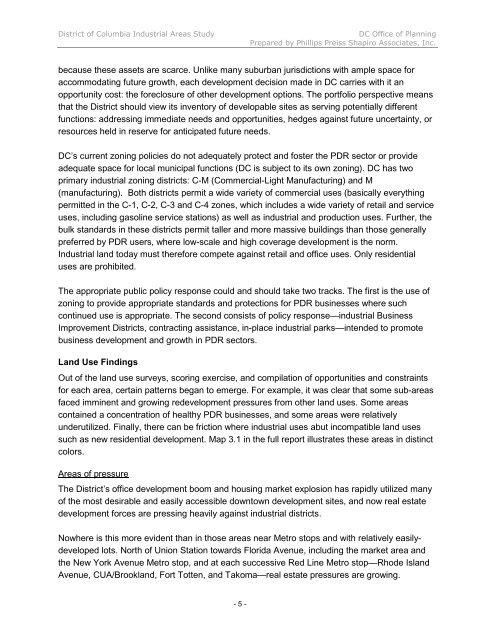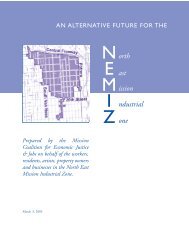INDUSTRIAL LAND IN A POST-INDUSTRIAL CITY District of ...
INDUSTRIAL LAND IN A POST-INDUSTRIAL CITY District of ...
INDUSTRIAL LAND IN A POST-INDUSTRIAL CITY District of ...
Create successful ePaper yourself
Turn your PDF publications into a flip-book with our unique Google optimized e-Paper software.
<strong>District</strong> <strong>of</strong> Columbia Industrial Areas Study DC Office <strong>of</strong> Planning<br />
Prepared by Phillips Preiss Shapiro Associates, Inc.<br />
because these assets are scarce. Unlike many suburban jurisdictions with ample space for<br />
accommodating future growth, each development decision made in DC carries with it an<br />
opportunity cost: the foreclosure <strong>of</strong> other development options. The portfolio perspective means<br />
that the <strong>District</strong> should view its inventory <strong>of</strong> developable sites as serving potentially different<br />
functions: addressing immediate needs and opportunities, hedges against future uncertainty, or<br />
resources held in reserve for anticipated future needs.<br />
DC’s current zoning policies do not adequately protect and foster the PDR sector or provide<br />
adequate space for local municipal functions (DC is subject to its own zoning). DC has two<br />
primary industrial zoning districts: C-M (Commercial-Light Manufacturing) and M<br />
(manufacturing). Both districts permit a wide variety <strong>of</strong> commercial uses (basically everything<br />
permitted in the C-1, C-2, C-3 and C-4 zones, which includes a wide variety <strong>of</strong> retail and service<br />
uses, including gasoline service stations) as well as industrial and production uses. Further, the<br />
bulk standards in these districts permit taller and more massive buildings than those generally<br />
preferred by PDR users, where low-scale and high coverage development is the norm.<br />
Industrial land today must therefore compete against retail and <strong>of</strong>fice uses. Only residential<br />
uses are prohibited.<br />
The appropriate public policy response could and should take two tracks. The first is the use <strong>of</strong><br />
zoning to provide appropriate standards and protections for PDR businesses where such<br />
continued use is appropriate. The second consists <strong>of</strong> policy response—industrial Business<br />
Improvement <strong>District</strong>s, contracting assistance, in-place industrial parks—intended to promote<br />
business development and growth in PDR sectors.<br />
Land Use Findings<br />
Out <strong>of</strong> the land use surveys, scoring exercise, and compilation <strong>of</strong> opportunities and constraints<br />
for each area, certain patterns began to emerge. For example, it was clear that some sub-areas<br />
faced imminent and growing redevelopment pressures from other land uses. Some areas<br />
contained a concentration <strong>of</strong> healthy PDR businesses, and some areas were relatively<br />
underutilized. Finally, there can be friction where industrial uses abut incompatible land uses<br />
such as new residential development. Map 3.1 in the full report illustrates these areas in distinct<br />
colors.<br />
Areas <strong>of</strong> pressure<br />
The <strong>District</strong>’s <strong>of</strong>fice development boom and housing market explosion has rapidly utilized many<br />
<strong>of</strong> the most desirable and easily accessible downtown development sites, and now real estate<br />
development forces are pressing heavily against industrial districts.<br />
Nowhere is this more evident than in those areas near Metro stops and with relatively easilydeveloped<br />
lots. North <strong>of</strong> Union Station towards Florida Avenue, including the market area and<br />
the New York Avenue Metro stop, and at each successive Red Line Metro stop—Rhode Island<br />
Avenue, CUA/Brookland, Fort Totten, and Takoma—real estate pressures are growing.<br />
- 5 -












